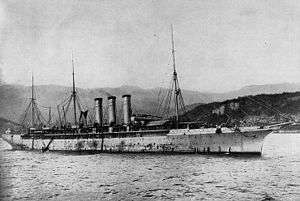USS Yale (1888)
 USS Yale (1889) USS Harrisburg (1918-19) | |
| History | |
|---|---|
| Launched: | 23 October 1888 |
| Acquired: | 27 April 1898 |
| Commissioned: |
|
| Decommissioned: |
|
| In service: | 1898, 1918–1919 |
| Struck: |
|
| Reinstated: | 1918 USS Harrisburg |
| Homeport: | New York |
| Fate: | scrapped at Genoa, Italy, in 1923 |
| General characteristics | |
| Displacement: | 10,499 grt |
| Length: | 560 feet |
| Beam: | 63.2 feet |
| Speed: | 20 knots |
| Complement: | 436 |
| Armament: | 4 x 6-pounder + 4 x 3-pounder guns |
The USS Yale was originally built as the SS City of Paris, between 1888 and 1889 by J. & G. Thompson at Glasgow, Scotland. The U. S. Navy chartered her on 27 April 1898 from the International Navigation Co.; the Navy renamed her USS Yale, and commissioned her on 2 May 1898 under the command of Captain W. C. Wise. In 1918 she was recommissioned as USS Harrisburg, under the command of Commander Wallace Bertholf. After the war she returned to commercial service and was scrapped in 1923, following a mutiny of her crew.[1]
Navy Service
On the day of her commissioning into the Navy, Yale put to sea from New York, bound for Puerto Rico to patrol and help locate Admiral Cervera's Spanish fleet during the Spanish–American War. On 8 May, two days after her arrival off Puerto Rico, Yale encountered and captured the Spanish cargo ship Rita, installed a prize crew in her, and sent her into Charleston, South Carolina.
The following day she had another brief encounter with the enemy off San Juan when a Spanish armed transport came out and fired a few shots. Yale was far more weakly armed than her opponent and retired from the scene. She returned to San Juan the following day, where a shore battery at Fort San Cristobal, under the orders of Captain Angel Rivero Mendez, fired two poorly aimed shots at her with its Ordóñez guns; both shots fell far short.
Pursuant to her orders, Yale patrolled off Puerto Rico until 13 May, at which time she left for St. Thomas in the Danish West Indies (Virgin Islands) to telegraph her report to Washington. She returned briefly to Puerto Rico on 16 and 17 May, then headed for Cap-Haïtien, Haiti, in company with St. Paul. She remained at Cap-Haïtien until 21 May, then headed for waters off Santiago de Cuba where the Spanish fleet had been discovered. Yale remained there while the United States fleet assembled off Santiago to blockade Cervera's ships in that port. On the 28th, she quit the area; stopped briefly at Port Antonio, Jamaica; and then set a course for Newport News, Virginia. The ship spent 20 days at Newport News, heading back to Cuba on 23 June. She arrived off Santiago on 27 June but remained there only two days. On the 29th, she got underway for Key West, Florida, stopping there overnight on 3 and 4 July before continuing on to Charleston. Yale returned to Santiago on 11 July and remained in Cuban waters until the 17th. After participating in the invasion of Puerto Rico at Guánica, Puerto Rico, she set a course for New York on 26 July. She spent most of the first two weeks of August in New York and returned to Cuba on the 15th. Remaining only briefly, she embarked troops for the return voyage to New York.
Return to commercial service
Yale arrived back in New York on 23 August and remained there until decommissioned on 2 September 1898. Though returned to her owners after decommissioning, Yale was not struck from the Navy List until 3 July 1899. She returned to merchant service—first under the name SS City of Paris.
World War I
During World War I, the liner, which had been renamed SS Philadelphia in 1901, operated out of New York as a troop transport for the U.S. Army. The Navy took her over in 1918, placing her in commission as Harrisburg (ID # 1663) in late May. For the remainder of the conflict she continued to take troops to Europe, making four voyages to England and France before the November 1918 Armistice brought an end to the fighting. She then reversed the flow, making six more trips to transport servicemen home from the former war zone.
Post-war service and fate
USS Harrisburg was decommissioned in September 1919 and returned to commercial service as Philadelphia. In August 1922, the crew of Philadelphia mutinied. The ship was in arrears from repairs received in the Bay of Naples and Italian customs officials refused her permission to depart. Contemporaneous news outlets described the crew as Bolsheviks and members of the IWW. True or not, they ransacked and burned the ship, leading the Italian authorities to arrest them.[1][2][3] Philadelphia was subsequently scrapped in 1923.[4][5]
See also
SS City of Paris for the ship's civilian career
References
- 1 2 "Crew of Philadelphia Tell of Mutiny in Naples Harbor" (PDF). The Evening Telegram. 1922-09-07. pp. 1,4.
- ↑ "Naples Mutiny". The Advocate (Australia). 1922-08-25. p. 1.
- ↑ "Booze, Brawls and Blaze on Terror Voyage". New-York Tribune. 1922-09-08. p. 6.
- ↑ Urrutia, John (2012). No Monkey Business in This House!. iUniverse. p. 95. ISBN 9781475932287.
- ↑ Villard, Harold G., ed. (1922-09-02). "Sidelights". The Nautical Gazette 103 (10): 302.
- This article incorporates text from the public domain Dictionary of American Naval Fighting Ships. The entry can be found here.
- USN Ships profile: USS Yale (1898), USS Harrisburg (ID # 1663), 1918-1919